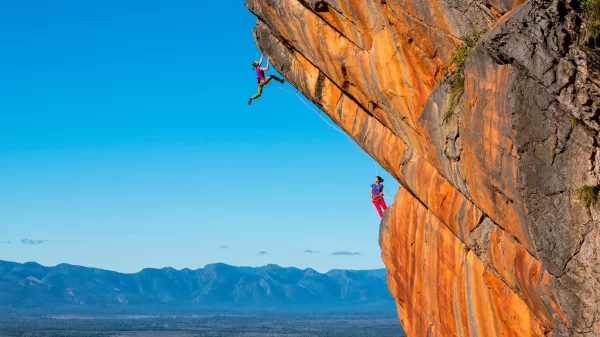A good morning in the Sahara
Waking with the sun hot on my face and struggling to open my eyes, I glanced across the rusty Sahara Desert to see if anyone was stirring. I was travelling with a small group of friends, and we had spent the night sleeping under the stars with only the soft sand for a mattress.
With everyone still asleep, I climbed up a large dune alone to get a better glimpse of what we’d come here to find. There, several kilometres away, hundreds of enormous pyramids rose out of the desert – a site that few travellers have seen before. (Credit: Vivien Cumming)
The lost pyramids of Sudan
From 2600 BC until approximately 300 AD, this area known as ancient Nubia was ruled by the Kushites, who were both enemies and friends of the Egyptians (at different times) and followed many of their rituals, such as burying their kings and queens in pyramid tombs. There are more than 250 pyramids along the Nile in Sudan, far outnumbering their Egyptian cousins. (Credit: Vivien Cumming)
A journey back in time
We had been lured to Sudan by a friend who had spent three years teaching English in a school in Khartoum and was full of fascinating anecdotes about exploring ancient Nubia, cooking over campfires among sand dunes and meeting archaeologists who have discovered artefacts left behind by 5,000-year-old civilisations. We decided to visit him and take a journey back in time, driving along the Nile from Khartoum to Dongola, exploring the pyramids and other ruins along the way. (Credit: Vivien Cumming)
A Sudanese roadside stop
Sudan isn’t a usual tourist destination, and it’s by no means an easy place to travel. Visas to enter the country require a mountain of paper work and phone reception is rare. But these are small prices to pay for the wealth of ancient history in a country with overwhelmingly friendly and hospitable people.
In Khartoum, we hired a car with a local driver to help us negotiate the slow, bumpy roads and numerous police checkpoints (terrorism is a constant threat in Sudan). As it can take several hours to go just 100km, roadside breaks were a must. At popup stalls in villages along the way, we were warmly greeted with cups of sweet tea and offered beds that were laid out for people to rest from their long journeys. (Credit: Vivien Cumming)
The remains of an ancient capital
Along the road going north out of Khartoum, our first major stop were the pyramids at Meroe, the capital of the Kushite kingdom from 300 BC (previous capitals included Kerma and Napata). Standing alone in the Sudanese desert for more than 2,000 years, they were built after the Egyptian pyramids and served as tombs for Meroe’s kings and queens. They sit close to the Nile, an important source of water and a trade route to Egypt, linking many of the ancient ruins found in present day Sudan. (Credit: Vivien Cumming)
Not Egypt’s pyramids
Unlike Egypt’s Pyramids of Giza, most of Meroe‘s pyramids are slightly smaller, with steeper sides, narrower bases and adjoining offering temples. They lie in varying states of disrepair due to the plundering of treasure hunters in the 1800s: some stand tall in perfect condition, others are unrecognizable piles of rubble. Their distinctively darker colour is due to the higher iron content in the rocks.
The pyramids at Meroe were listed as a Unesco World Heritage site in 2011, but owing to its location in northeastern Sudan – a place that conjures up images of war and economic crisis – it receives very few visitors, usually no more than 10 a day. (Credit: Vivien Cumming)
The pyramids few visitors see
A lonely ticket man greeted us at the entrance to the World Heritage site. We then headed over to the first group of about nine pyramids in the South Cemetery. (Meroe has three cemeteries – North, South and West – within a few kilometres of each other).
Walking among the pyramids, I felt dwarfed by the sheer scale of the surrounding antiquity. I touched the side of a sand blasted rock and it felt warm as its dark colour absorbed the hot desert sun. (Credit: Vivien Cumming)
Carvings into the stone
We were able to walk or crawl into some of the offering temples that hadn’t been taken over by sand. They were small spaces, only a few metres by a few metres, but inside, there were fascinating wall carvings depicting various scenes of life in the Kushite kingdom – including Queens presiding over their subjects and people worshiping Egyptian gods. In one temple, a carving revealed evidence that the royal buried inside the pyramid was mummified, covered with jewellery and laid to rest in a wooden case. (Credit: Vivien Cumming)
A visit from locals
We had been exploring for about an hour when we saw a small child running towards us, quickly followed by a few more. News of our arrival had obviously spread through the nearby village of Kabushiya. The children brought handmade models of the pyramids carved out of local sandstone, and asked us – in a mix of broken English and Arabic – about where we were from.
Their parents arrived with camels to take us from one group of pyramids to the next, and we welcomed the alternative to trudging through the sand in the midday sun. (Credit: Vivien Cumming)
An archaeologist’s dream
The pyramids at Meroe are Sudan’s best-preserved pyramids; they have the highest numbers of tombs and are the most extensively excavated by archaeologists. However, as you drive along the Nile, it not uncommon to spot other groups of pyramids or ancient ruins in the distance.
Driving several hundred kilometres up the river towards the city of Dongola, we visited the renowned archaeological site at Kerma, home to the Kingdom of Kerma more than 5,000 years ago. Although they were influenced by the Egyptians, the people of Kerma were a civilisation in their own right, ruling over ancient Nubia before the Kushites arrived and built the pyramids. At Kerma today, you can see the oldest mud brick building in Africa (pictured), a huge tomb surrounded by smaller burial sites. (Credit: Vivien Cumming)
A carved pharaoh left behind
In 2003, more than 40 large granite statues of pharaohs, thought to have been rulers of the Kushite empire, were found scattered through the desert near Kerma. Most of these statues were collected and put into museums – but some (like this weathered one lying on its side) have remained in the desert for travellers like me to uncover. (Credit: Vivien Cumming)

















































